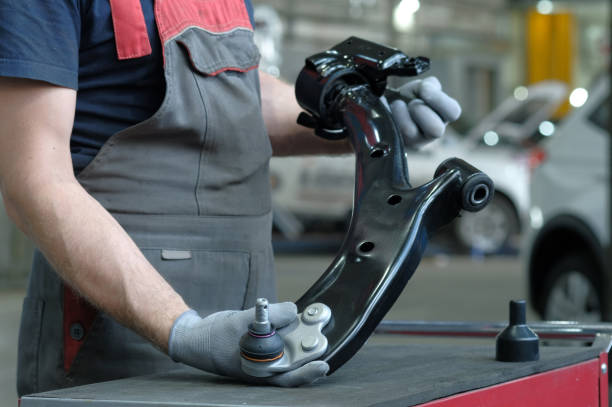A Comprehensive Guide to Control Arm Configurations and Real-World Applications
Control arms, also known as suspension arms or A-arms, are critical components of a vehicle’s suspension system. They connect the wheel hub to the chassis, manage wheel alignment, and absorb road shocks. The number of control arms varies significantly depending on the vehicle type, suspension design, and performance requirements. Let’s break down the details with technical data and real-world examples.
1. Control Arm Basics: Function and Design
Control arms work in tandem with other suspension components (e.g., shocks, springs) to:
- Maintain wheel alignment (camber, caster, and toe angles).
- Reduce vibrations and impacts from uneven roads.
- Allow vertical wheel movement while limiting lateral motion.
Key design elements:
- Material: Steel (cost-effective), aluminum (lightweight), or forged composites (high-end).
- Bushings: Rubber (comfort) vs. polyurethane (durability).
- Ball joints: Pivotal for steering articulation.
2. Typical Control Arm Count by Vehicle Type
① Passenger Cars (Sedans and Hatchbacks)
Example: 2023 Toyota Corolla
- Front suspension: MacPherson strut system
- Control arms: 2 (1 lower control arm per side).
- Material: Steel stamping with rubber bushings.
- Weight: ~5.2 kg each.
- Rear suspension: Torsion beam (non-independent)
- Control arms: 0 (integrated beam design).
Total control arms: 2
② SUVs and Crossovers
Example: 2023 Honda CR-V
- Front suspension: MacPherson strut with dual lower arms
- Control arms: 4 (2 lower arms per side for enhanced stability).
- Material: Forged aluminum (upper arm), steel (lower arm).
- Weight savings: Aluminum arms reduce unsprung mass by 18%.
- Rear suspension: Multi-link independent
- Control arms: 6 (3 per side: upper, lower, and toe arm).
Total control arms: 10
③ Luxury Performance Vehicles
Example: 2023 BMW 5 Series
- Front suspension: Double-wishbone
- Control arms: 4 (2 upper and 2 lower arms).
- Material: Cast aluminum with hydraulic bushings.
- Stiffness: 15% higher than standard steel arms.
- Rear suspension: Integral-V multi-link
- Control arms: 8 (4 per side, including camber and trailing arms).
Total control arms: 12
④ Heavy-Duty Trucks
Example: 2024 Ford F-150 Raptor
- Front suspension: Solid axle with radius arms
- Control arms: 2 (radius arms for axle positioning).
- Material: High-strength steel (yield strength 550 MPa).
- Rear suspension: Leaf spring with trailing arms
- Control arms: 2 (trailing arms for axle control).
Total control arms: 4
3. Technical Specifications and Innovations
Material Comparison
| Material | Tensile Strength | Weight Savings | Cost | Example Application |
|---|---|---|---|---|
| Steel | 350-500 MPa | Baseline | 50−50−100/arm | Toyota Camry (lower arm) |
| Aluminum | 250-350 MPa | 30-40% | 150−150−300/arm | Audi A4 (upper arm) |
| Forged Carbon | 600-800 MPa | 50% | $400+/arm | Porsche 911 GT3 |
Bushing Types
- Rubber bushings:
- Durometer: 60-70 Shore A.
- Lifespan: ~120,000 km.
- Polyurethane bushings:
- Durometer: 80-90 Shore A.
- Lifespan: ~200,000 km.
4. Real-World Case Studies
Case 1: Tesla Model Y
- Front suspension: Double-wishbone with 2 upper and 2 lower arms.
- Innovation: Hydroformed aluminum arms with hollow sections for weight reduction (total front arm weight: 8.7 kg).
- Durability: Rated for 300,000 km under Tesla’s “Full Self-Driving” stress tests.
Case 2: Mercedes-Benz Actros Truck
- Suspension: Air suspension with 6 control arms (front and rear).
- Load capacity: Supports up to 25,000 kg GVWR.
- Material: Reinforced steel with zinc-nickel coating (corrosion resistance: 2,000 hours salt spray test).
Case 3: OK PARTS Performance Control Arms
- Product: OK-TCA-AL202 (Forged aluminum control arm).
- Compatibility: Fits Ford F-150 (2015-2023).
- Weight: 3.8 kg (vs. OEM steel arm’s 6.5 kg).
- Strength: 320 MPa tensile strength, tested for 500,000 cycles at 2.5x load capacity.
- Warranty: 5-year/unlimited mileage.
5. Why Control Arm Configuration Matters
- Handling: More arms (e.g., multi-link setups) improve cornering stability.
- Comfort: Rubber-bushed arms absorb road noise better than polyurethane.
- Durability: Heavy-duty arms with anti-corrosion coatings extend service life in harsh climates.
6. Maintenance Tips
- Inspection interval: Check bushings and ball joints every 50,000 km.
- Failure signs: Clunking noises, uneven tire wear, or misalignment.
- Upgrade options: Replace steel arms with OK PARTS aluminum arms for better performance.
Key Takeaways
- Standard sedans: 2-4 control arms.
- Luxury/performance vehicles: 8-12 control arms.
- Material innovation: Aluminum and forged composites are revolutionizing weight and strength ratios.
For fleet managers and auto retailers, choosing the right control arm supplier—like OK PARTS—ensures durability, cost efficiency, and compatibility with global vehicle platforms.
OK-PART

